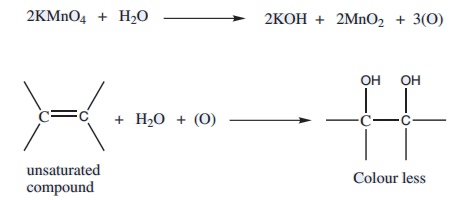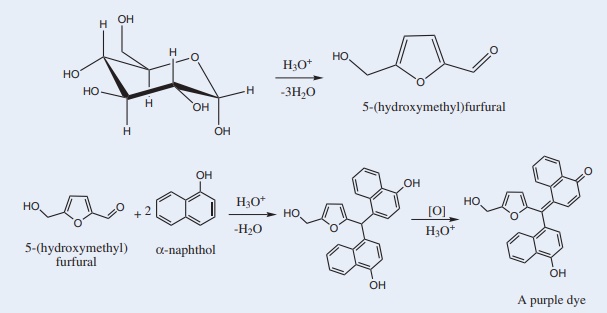Chemistry Practical Laboratory Experiment - Reasoning - Organic Qualitative Analysis | 12th Chemistry : Practicals
Chapter: 12th Chemistry : Practicals
Reasoning - Organic Qualitative Analysis
REASONING - ORGANIC QUALITATIVE
ANALYSIS
3. Action with sodium bicarbonate:
Carboxylic
acids react with sodium bi carbonate and liberate CO2. Evolution of
carbon dioxide gives brisk effervescence.
2R-COOH+
2NaHCO3 →2R-COONa+CO2 ↑ + H2O
4. Action with Borsches reagent:
Borsches
reagent is prepared by dissolving 2,4-dinitrophenylhydrazine in a solution
containing methanol and little of conc sulphuric acid.
Aldehydes
and ketones react with borsches reagent to form yellow, orange or red
precipitate (dinitro phenylhydrazone)
Aliphatic
carbonyl compounds give deep yellow precipitate.
Aromatic
carbonyl compounds give red precipitate.
2,4-dinitrophenyl
hydrazine can be used to qualitatively detect the carbonyl group of an aldehyde
or ketone. A positive result is indicated by the formation of an yellow or
orange-red precipitate of 2,4-dinitrophenyl hydrazone.

5. Charring test:
When
carbohydrates are treated with concentrated sulphuric acid, dehydration of
carbohydrates results in charring.

6. Ignition test
Aromatic
compounds burn with a strong sooty yellow flame because of the high
carbon–hydrogen ratio. Aliphatic compounds burn with non-sooty flame.
7. Test with bromine water:
In this
test, the orange-red colour of bromine solution disappears when it is added to
an unsaturated organic compound.

8. Test with KMnO4 (Baeyer’s Test )
In this
test, pink colour of KMnO4 disappears, when alkaline KMnO4
is added to an unsaturated hydrocarbon. The disappearance of pink colour may
take place with or without the formation of brown precipitate of MnO2.

9. Neutral FeCl3 test:
Phenol
reacts with ferric ions to form violet coloured complex.
Aqueous
solution Naphthols do not give any characteristic colour with neutral ferric
chloride. But alcoholic solution of α and β naphtholsgiveblue-violet and
green colouration respectively due to the formation of binaphthols.
10. Esterification test:
Alcohols
react with carboxylic acids to form fruity smelling compounds called esters.
This esterification is catalysed by an acid such as concentrated sulphuric
acid.

11. Tollen’s reagent test:
Aldehydes
react with Tollen’s reagent to form elemental silver, accumulated onto the
inner surface of the test tube. Thus silver mirror is produced on the inner
walls of the test tube.

Tollen’s reagent preparation:
Tollen’s
reagent is ammoniacal silver nitrate. It is prepared as follows. About 1 g of
silver nitrate crystals are dissolved in distilled water in a clean dry test
tube. To this aqueous solution of silver nitrate, add 2 ml of dilute NaOH
solution to it. A brown precipitate of silver oxide is formed. This precipitate
is dissolved by adding dilute ammonia solution drop wise.
12. Fehling’s Test
Fehling’s
solution A is an aqueous solution of copper sulphate.
Fehling’s
solution B is a clear solution of sodium potassium tartrate (Rochelle salt) and
strong alkali (NaOH).
The
Fehling’s solution is obtained by mixing equal volumes of both Fehling’s
solution A and Fehling’s solution B that has a deep blue colour. In Fehling’s
solution, copper (II) ions form a complex with tartrate ions in alkali.
Aldehydes reduces the Cu(II) ions in the Fehling’s solution to red precipitate
of cuprous oxide(copper (I) oxide).

Note:
Benzaldehyde may not give this test as the reaction is very slow.
13. Sodium nitroprusside Test
The anion
of the ketone formed by a alkali reacts with nitroprusside ion to form a red
coloured complex.this test is not given by aldehydes.

14. Azo-Dye Test
This test
is given by aromatic primary amines. Aromatic primary amines react with nitrous
acid to form diazonium salts. These diazonium salts undergo coupling reaction
with β-naphthol to form orange coloured azo dye.

15. Biuret test
On strong
heating Diamide (like urea) form biuret, which forms a copper complex with Cu2+
ions from copper sulphate solution. This copper –biuret complex is deep violet
coloured.

16. Molisch’s test:
Disaccharides,
and polysaccharidesare hydrolysed to Monosaccharides by strong mineral acids.
Pentoses are then dehydrated to furfural, while hexoses are dehydrated to
5-hydroxymethylfurfural. These aldehydes formed will condense with two
molecules of α-Naphthol to form a purple-coloured product, as shown below.

17. Osazone test:
Phenyl
hydrazine in acetic acid, when boiled with reducing sugars forms Osazone. The
first two carbon atoms are involved in this reaction. The sugars that differ in
their configuration on these carbon atoms give the same type of Osazone. Thus
glucose, fructose and mannose give the same needle type yellow crystals.






Related Topics